Related Research Articles

The Balducci levitation is a levitation illusion first described by Ed Balducci. Its inventor is unknown. It is an impromptu magic trick, which has been popularized by many magicians, such as David Roth, Paul Harris, and David Blaine.

Erik Weisz, known as Harry Houdini, was a Hungarian-American escape artist, illusionist, and stunt performer, noted for his escape acts. His pseudonym is a reference to his mentor in magic, French magician Robert-Houdin (1805–1871).

Jean-Eugène Robert-Houdin was a French watchmaker, magician and illusionist, widely recognized as the father of the modern style of conjuring. He transformed magic from a pastime for the lower classes, seen at fairs, to an entertainment for the wealthy, which he offered in a theatre opened in Paris, a legacy preserved by the tradition of modern magicians performing in tails.

David Seth Kotkin, known professionally as David Copperfield, is an American magician, described by Forbes as the most commercially successful magician in history.
Sleight of hand refers to fine motor skills when used by performing artists in different art forms to entertain or manipulate. It is closely associated with close-up magic, card magic, card flourishing and stealing. Because of its heavy use and practice by magicians, sleight of hand is often confused as a branch of magic; however, it is a separate genre of entertainment and many artists practice sleight of hand as an independent skill. Sleight of hand pioneers with worldwide acclaim include Dan and Dave, Ricky Jay, Derek DelGaudio, David Copperfield, Yann Frisch, Norbert Ferré, Dai Vernon, Cardini, Tony Slydini, Helder Guimarães and Tom Mullica.

Harry Bouton Blackstone Jr. was an American stage magician, author, and television performer. He is estimated to have pulled 80,000 rabbits from his sleeves and hats.
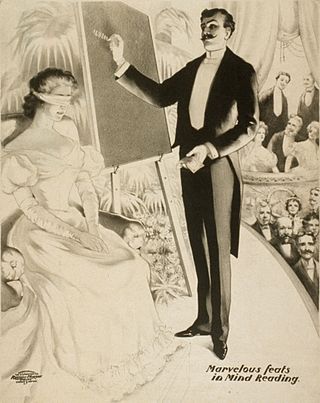
Mentalism is a performing art in which its practitioners, known as mentalists, appear to demonstrate highly developed mental or intuitive abilities. Performances may appear to include hypnosis, telepathy, clairvoyance, divination, precognition, psychokinesis, mediumship, mind control, memory feats, deduction, and rapid mathematics. Mentalists perform a theatrical act that includes special effects that may appear to employ psychic or supernatural forces but that are actually achieved by "ordinary conjuring means", natural human abilities, and an in-depth understanding of key principles from human psychology or other behavioral sciences.
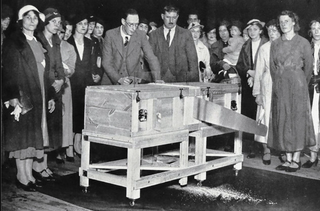
Sawing a woman in half is a generic name for a number of stage magic tricks in which a person is apparently cut or divided into two or more pieces.
The Indian rope trick is a magic trick said to have been performed in and around India during the 19th century. Sometimes described as "the world’s greatest illusion", it reputedly involved a magician, a length of rope, and one or more boy assistants.
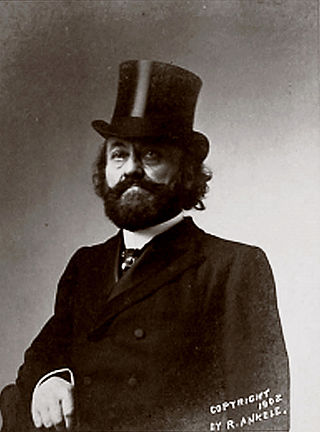
Buatier de Kolta was a French magician who performed throughout the latter part of the 1800s in Europe and the United States.
This is a glossary of conjuring terms used by magicians.
David Copperfield has performed a levitation illusion in several magic shows since 1992 in which he appears to fly on stage for several minutes, while surrounded by audience members. The flight is notable for its graceful motion and unencumbered appearance. The illusion was included in Copperfield's CBS TV special The Magic of David Copperfield XIV: Flying—Live The Dream (1992), and has been repeated several times during Copperfield's live tours around the world. The method was created by John Gaughan. An essential contribution to make fluid movements was given by his assistant, dancer and choreographer Joanie Spina.

Jim Steinmeyer is an American author, inventor, and designer of magical illusions and theatrical special effects. He holds four US patents in the field of illusion apparatus, including a modern version of the Pepper's Ghost illusion. Steinmeyer has consulted for many famous magicians, including David Copperfield, Doug Henning, Siegfried and Roy, and Lance Burton.
Platform magic is magic that is done for larger audiences than close-up magic and for smaller audiences than stage magic. It is more intimate than stage magic because it does not require expensive, large-scale stage equipment and can thus be performed closer to the audience and without a stage. Many of the tricks performed by platform magicians are sufficiently angle-sensitive as to make them impossible to perform as micromagic. Most working magicians are parlor/platform magicians.

Magic, which encompasses the subgenres of illusion, stage magic, and close-up magic, among others, is a performing art in which audiences are entertained by tricks, effects, or illusions of seemingly impossible feats, using natural means. It is to be distinguished from paranormal magic which are effects claimed to be created through supernatural means. It is one of the oldest performing arts in the world.
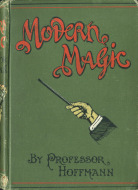
Modern Magic by Professor Hoffmann is a treatise in book form, first published in 1876, detailing the apparatus, methods and tricks used by the magicians and conjurors of that era. Hoffmann was considered to be one of the greatest authorities on the theory and practice of magic, despite his own limited professional experience as a magician.

A levitation illusion is one in which a magician appears to defy gravity by making an object or person float in the air. The subject may appear to levitate unassisted, or it may be performed with the aid of another object in which case it is termed a "suspension".
The Houdini Museum of New York is a museum exhibiting memorabilia related to the escape artist, Harry Houdini. It is located at Fantasma Magic, a retail magic manufacturer.
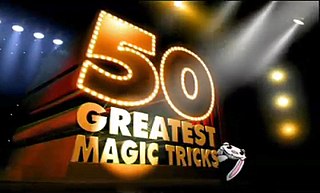
50 Greatest Magic Tricks is a one-off list show that was produced by Objective Productions for Channel 4. The programme counted down the fifty greatest magic tricks, as voted for by members of The Magic Circle. The illusion at number one was Death Saw by David Copperfield. The show was presented by British comedy duo Adam and Joe, who also wrote and narrated the programme. The show was first broadcast on Channel 4 on 6 May 2002.
References
- ↑ Copperfield, David; Wiseman, Richard; Britland, David (2021). David Copperfield's history of magic. New York, NY. ISBN 978-1-9821-1291-2. OCLC 1236259508.
{{cite book}}: CS1 maint: location missing publisher (link)
- Hay, Harry. Cyclopedia of Magic. (1949) ISBN 0-486-21808-2
